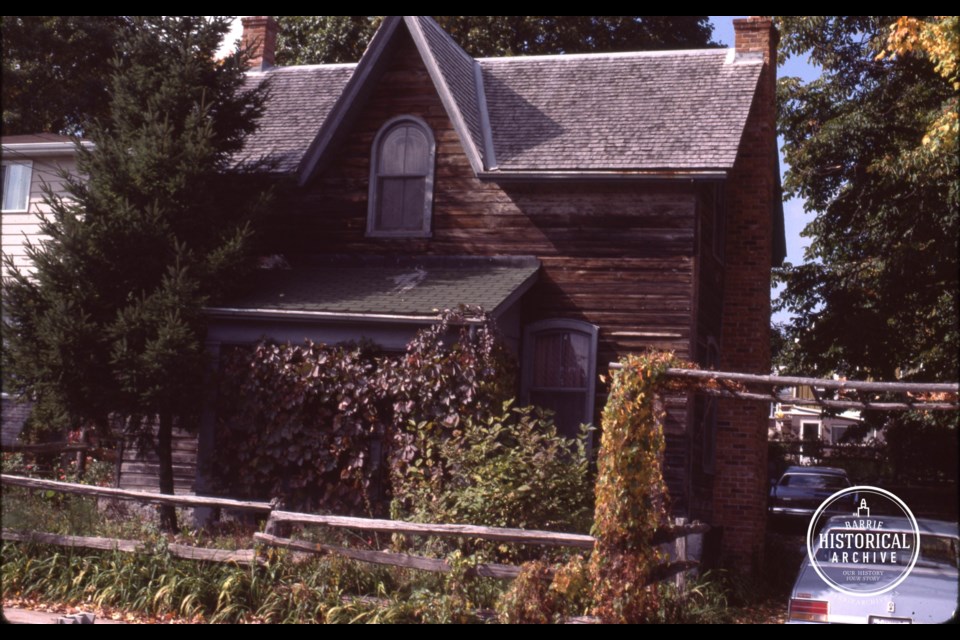This ongoing series from Barrie Historical Archive curator Deb Exel shows old photos from the collection and one from the present day, as well as the story behind them.
46 Grove St. E.
There are dozens of little Ontario Gothic-style farmhouses throughout Barrie. This one resides on Grove Street.
It wasn’t always called Grove Street. As early as 1851, it was known as John Street. John Bingham, an early pioneer, owned property in that area about 1866.
John Street ended at his farm, at the north end of Owen Street. Bingham’s home, Rose Cottage, more commonly remembered as Newton’s Farm, still stands near Grove and Davidson streets. This road, from Bayfield to Peel streets, was renamed Grove Street in 1910.
The most easterly end of Grove Street, from Penetanguishene Road to Duckworth Street, was called Back Street, named for Sir George Back, a British naval officer and Arctic explorer who passed through the town of Barrie in 1825 as part of Sir John Franklin’s second polar expedition.
If you’re not familiar with Back (I wasn’t), he was born in Stockport, England, in 1796 and joined the navy at the young age of 12. After only a year of service, he was taken by the French as a prisoner of war. When he was released, five years later, he was stationed in Halifax, N.S.
He first served under Franklin in 1818, accompanying him on the first Arctic land expedition of 1819 to 1822. On this expedition, now as a lieutenant, 374 miles of Arctic coast from the mouth of the Mackenzie River to Return Reef was mapped.
As a commander, Back led his first expedition, mapping the Great Fish (Thlew-ee-choh) River, later known as the Back River. His next expedition to map the Arctic coast, aboard the HMS Terror, became ice-bound, but Back still managed to explore the shoreline between Regent Inlet and Cape Turnagain.
Back was knighted in 1839 in recognition of his service and promoted to rear admiral, vice-admiral and, finally, admiral by 1876, before he died in London, England, in 1878. Back was considered the most important Arctic topographer of his day.
This eastern section of Back (Grove) Street was also known as Willowdale Avenue as late as 1964.
According to Dr. G. Curtis Spearin, a large grove of willow trees once stood in the area near Grove and Cook streets, which may explain the origin of the street name. The Spearins had a home on Back Street at one time, but their family’s log cabin on Steele Street had stood for five generations.
It was moved to the Simcoe County Museum in the early 1960s.
The veterinary clinic Spearin opened in 1950 still stands on the Steele Street property that once overlooked the ‘grove’ or ‘dale of willows.’
We now know the entire stretch from Penetanguishene Road to Toronto Street as Grove Street.
But our story is back at the little farmhouse at 46 Grove St. E., not far from Bayfield Street, or Mill Street as it was once known. In the 1870s, if the old records can be trusted. The property appears to have belonged to Robert Duffin Carson and Margaret Herron, both from Ireland. Carson’s father, William, came to Canada in 1835 with his wife, Agnes, and three children, settling in Toronto.
William’s family gradually made moves to Holland Landing and, eventually, to the village of Barrie located at the head of Kempenfelt Bay, building a shanty near the foot of Bayfield Street.
The Carsons later settled on a farm in Vespra Township. Robert and Margaret Carson, who married at Trinity Church in 1849, presumably lived in this Grove Street home.
It’s possible Elizabeth Ann (Carson) Alexander, wife of Samuel Alexander, lived in the Grove Street home, briefly, or at least owned it, after her parents, Robert and Margaret, died in the late 1880s.
Samuel was born in Barrie in 1848 to Irish immigrants, William Alexander and Susan Copeland. In 1876, Samuel, along with his brother-in-law, George Stevens, ran a teamster delivery business at the corner of Ross and John streets (now Maple Avenue).
Records show Elizabeth and Samuel married in 1879 at the Primitive Methodist Church in Barrie, planning to reside in Barrie after their marriage. However, they lived in the village of Anten Mills prior to 1883. Alexander Street in Anten Mills was named for this family.
Samuel worked at a sawmill in Anten Mills until it closed. Pursuing his interest in the lumber business, the family moved to Little Current on Manitoulin Island before returning to Barrie.
Land registry records show Elizabeth and Samuel Alexander on the title of this Grove Street property, briefly, in 1890. In 1912, the Alexanders purchased land in the Minesing area, where they had farmed for many years. Samuel died suddenly, in 1917, after completing his daily chores. Elizabeth died in 1930.
Barrie’s historic Grove neighbourhood is filled with homes, both grand and humble, all of them with rich histories of their occupants.



